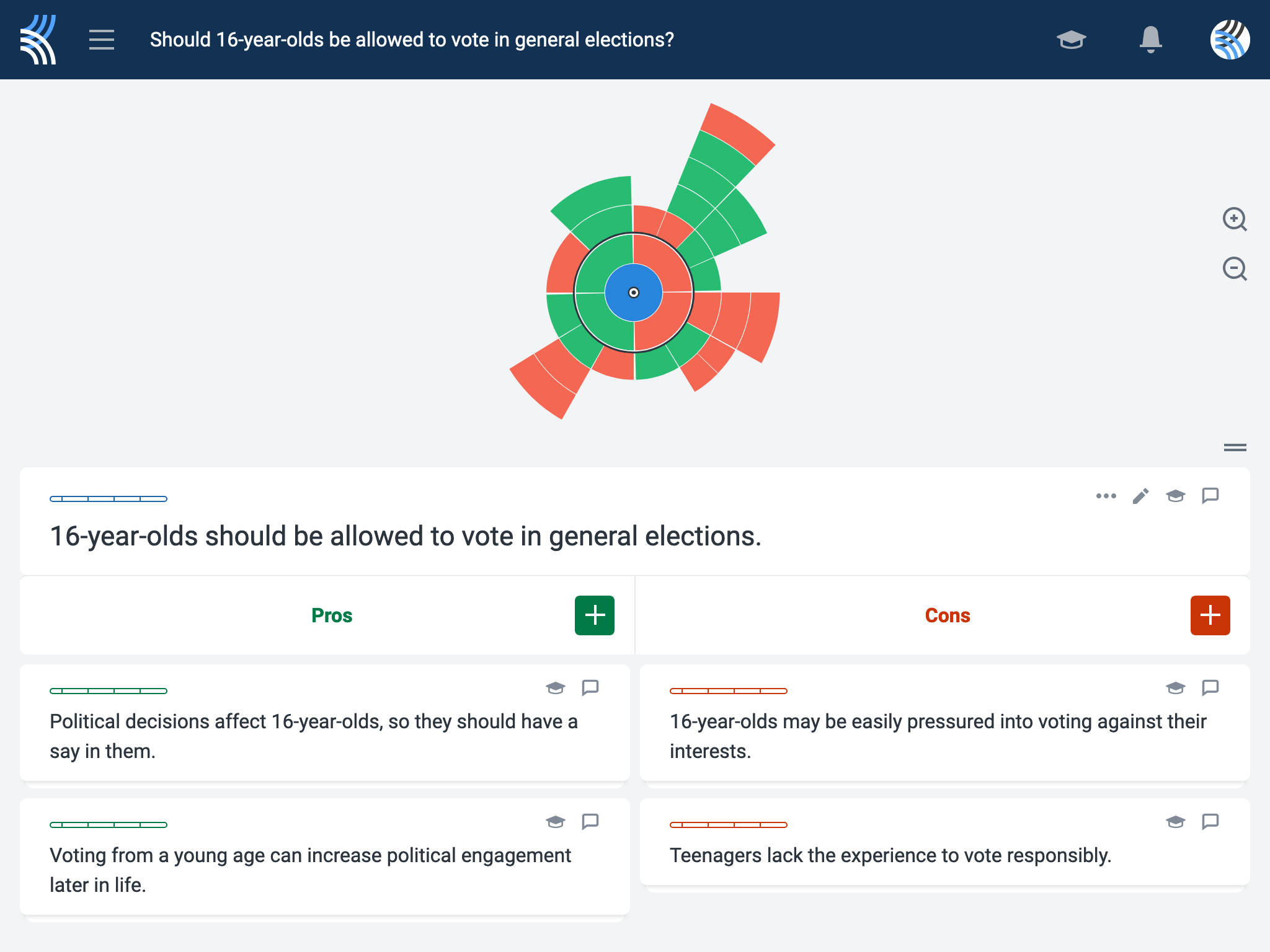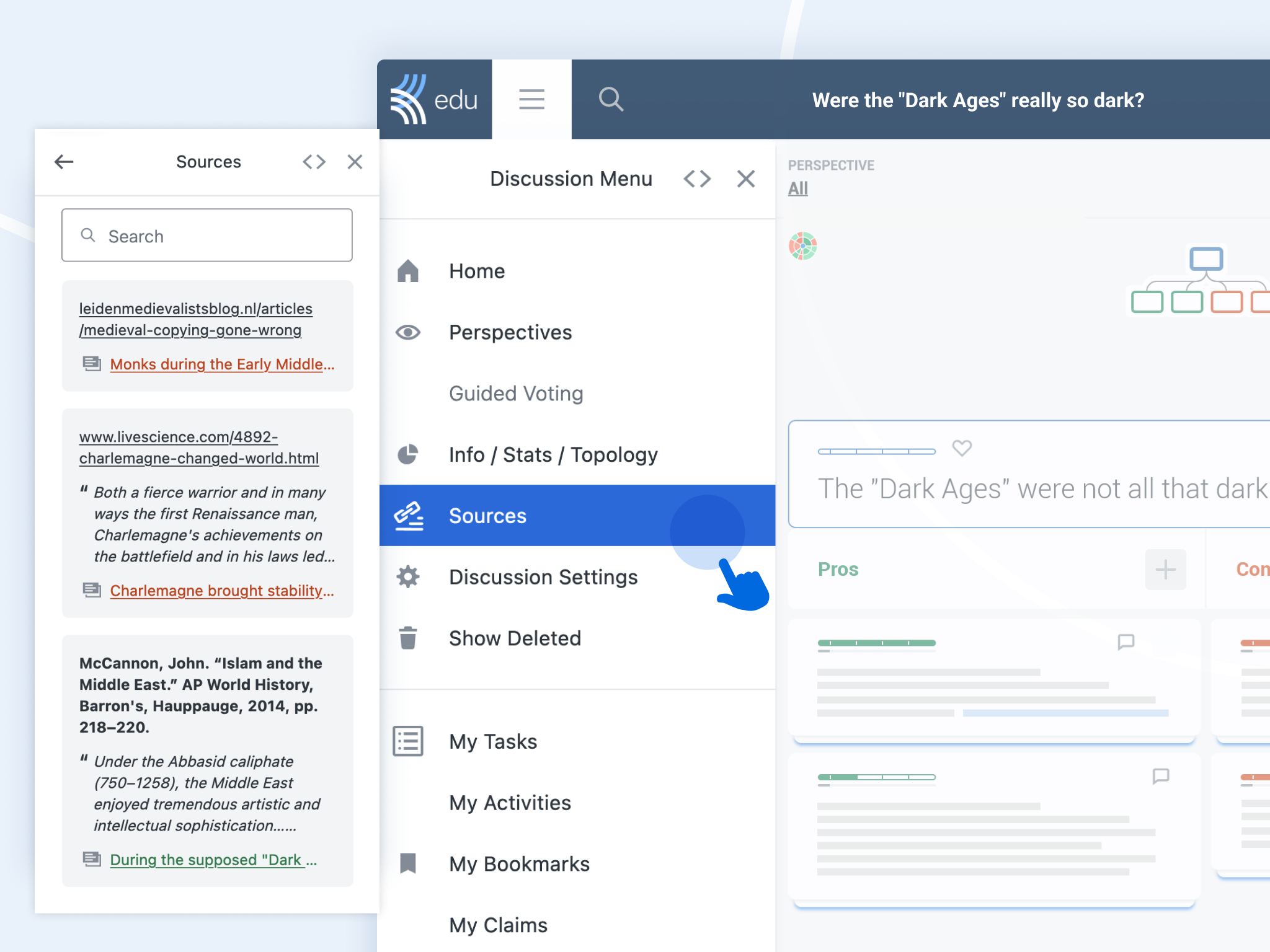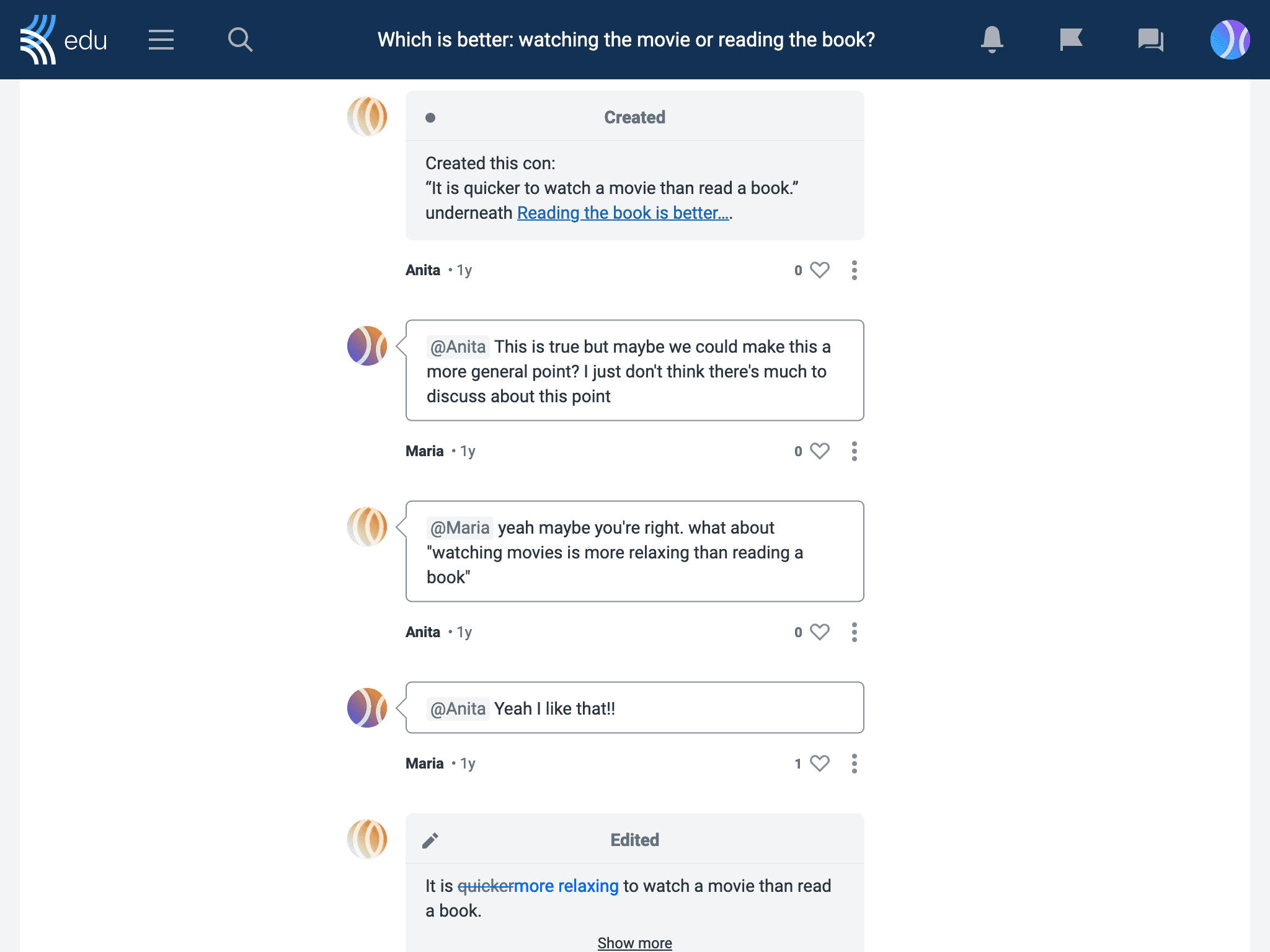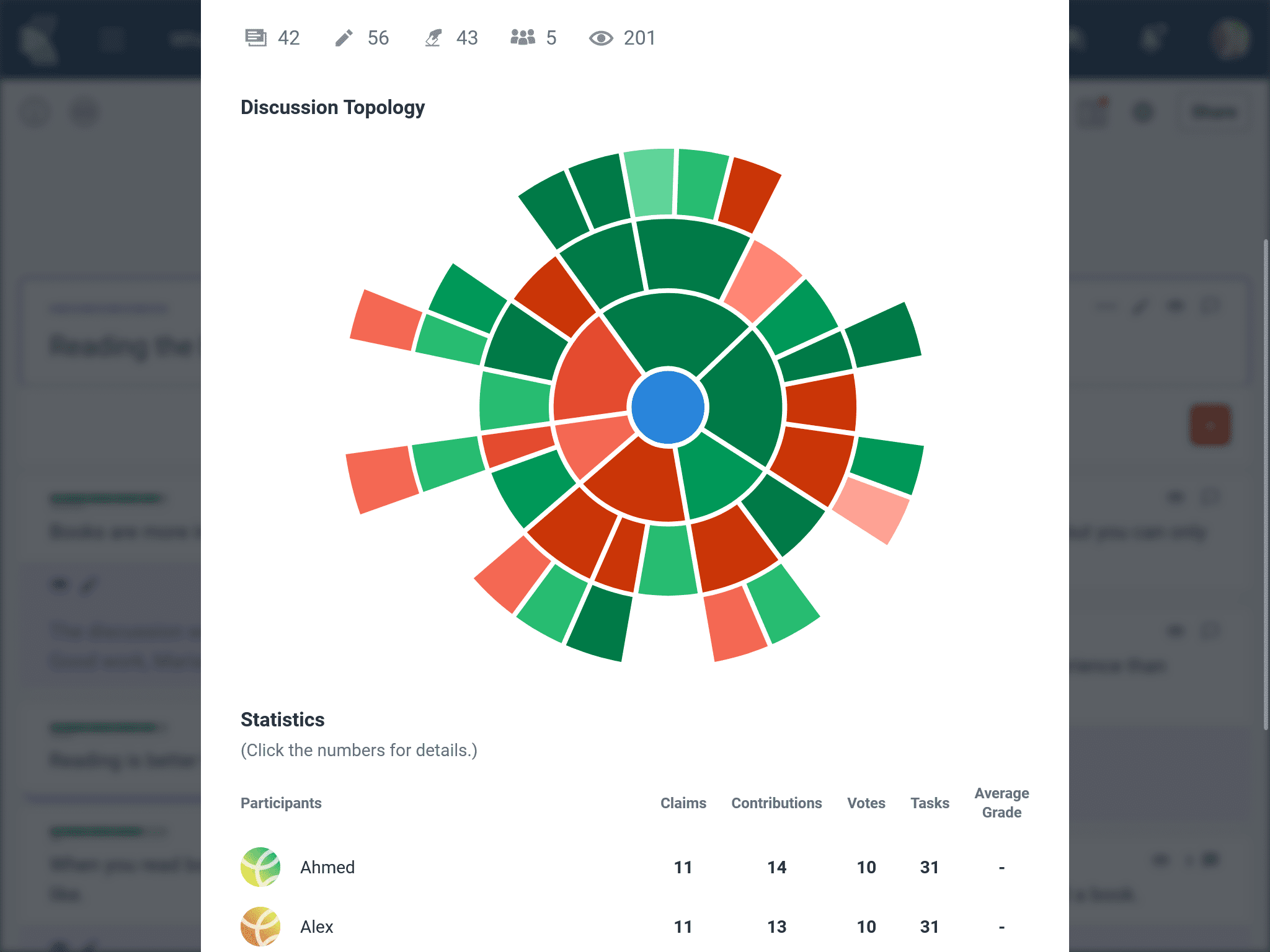As educators, we must equip our 21st-century students with the 21st-century skills they need to thrive in the digital age. Here, we have a range of engaging digital literacy activities ideal for the 21st-century student.
This collection of digital literacy activities on Kialo is designed to enhance students’ digital literacy skills, while developing essential 21st-century competencies: critical thinking, collaboration, communication, and creative thinking.
1. Engage in online discussions and debates to build students’ critical thinking skills
Online discussions and debates are ideal for developing students’ critical thinking skills. Explore a classroom discussion on Kialo, where students can engage with complex issues in a structured, moderated space, encouraging thoughtful interactions that lead to deeper understanding.

Simply choose a discussion from the Topic Library, or create your own discussion, and share it with your students.
Students can:
- Add pros and cons to build an interactive map of the whole discussion.
- Deconstruct their perspectives into step-by-step arguments, prompting self-reflection on the validity of each new claim.
- Analyze their peers’ perspectives and formulate counterarguments.
This interactive approach enhances critical thinking and digital literacy, empowering students to become responsible digital citizens.
2. Use lateral reading to evaluate digital sources
Lateral reading involves quickly scanning a source and seeking additional materials to verify information. This contrasts to the deep, vertical reading typical of traditional print methods. This is especially effective for digital sources, which often combine various media formats, making vertical methods less effective.
As Kialo discussions encourage students to use supporting evidence, they are ideal for students to practice lateral reading.

Once students have found an authoritative, credible source through lateral reading, they can link it to the relevant claim in the discussion. Students can outline their lateral reading strategies in the Quote/Note box, providing useful assessment evidence for educators.
3. Engage in collaborative online research to build students’ collaboration skills
In collaborative research projects, students learn to share responsibilities and harness each other’s strengths, creating a sense of community.
Kialo’s versatile discussion platform is ideal for structuring such projects. All students can contribute instantly and simultaneously, making it easy to build on each other’s research findings.
To split large classes into smaller groups, use Small Group Mode to give each group their own copy of the discussion.
Students can use the separate comments section for suggesting improvements or asking questions about research, so the body of the discussion stays focused on substantive ideas.

The sunburst minimap allows students to visualize the whole discussion and address any gaps in their collaborative research.

4. Participate in a virtual book club
A virtual book club is a great way to use collaboration to enhance students’ literacy and digital literacy.
Kialo’s discussions are a safe and secure way to facilitate a virtual book club – as a synchronous in-class activity or asynchronous homework activity. To set up the book club, educators should:
- Create a discussion, adding the central talking point of the text as the thesis.
- Invite students to the discussions and task them to add pros and cons to collaboratively analyze themes, characters, and the plot, enhancing both their teamwork skills and their literary knowledge.
For book club ideas, browse the literature category in Kialo’s Topic Library. Students could discuss whether Willy Wonka was good at heart, whether the children in Lord of the Flies were responsible for their actions, or whether Macbeth was a victim of fate.
5. Participate in a digital Socratic seminar to build students’ communication skills
Socratic seminars are structured discussions that promote meaningful dialogue around a specific question, topic, or text. Designed to create an inclusive environment, these seminars allow students to freely exchange ideas and respectfully challenge one another’s perspectives.
Kialo provides a useful supporting structure for Socratic seminars. Take these steps to set one up:
- To prepare collaboratively, students can use Kialo’s branching framework to outline their main ideas. Seeing each other’s perspectives helps students formulate targeted and thought-provoking questions.
- During the seminar, students can use the Kialo discussion to prompt their contributions. Referring to this outline enables them to articulate their perspectives more clearly.
- After the seminar, students can review their discussions and add new points, before giving each other constructive feedback.
6. Engage in role reversal
In a role reversal activity, students must argue for a position they initially disagree with, helping them practice empathy and gain a deeper understanding of diverse perspectives.
- Set up a new Kialo discussion on a controversial topic and identify the different stakeholders within the discussion.
- Students should contribute to the discussion in the role of a stakeholder who holds a different perspective to their own.
As students engage with differing opinions, they learn to respond thoughtfully and constructively, honing their civil discourse skills.
Asking students to apply creative approaches to solve social and community problems encourages them to discover ways to overcome conventional limitations, enabling them to develop fresh solutions.
Kialo’s multi-thesis discussions provide a structured format for creative problem-solving. Take these steps to guide students through the problem-solving process:
- Create a multi-thesis Kialo discussion, then introduce the problem and ask students to brainstorm potential solutions.
- Select the strongest – or most unique – ideas, and add them to the discussion as individual theses.
- Students break down each idea into manageable components, discussing the strengths and weaknesses of each.
- Students vote to select the strongest solution.
The hierarchical structure of claims encourages students to delve more deeply into each solution. This encourages creative thinking to overcome any potential challenges and leads to more imaginative and effective problem-solving.
8. Design innovative products
In a “Shark Tank” or “Dragons’ Den” challenge, combining creative thinking with digital literacy can spark the development of innovative products and services.
- Divide students into teams and specify a category such as health, education, or entertainment.
- Create a multi-thesis Kialo discussion. Students brainstorm ideas for a new product in the category, adding each idea as a thesis.
- In the discussion, students organize arguments for and against each idea.
- For claims, they should explore potential features, identify target audiences, and assess market viability.
- The group collaborates to refine the most promising idea into a detailed concept.
By the end of the discussion, students will have transformed their initial ideas into compelling pitches ready for the “sharks” or “dragons” to consider.
What is digital literacy?
UNESCO defines digital literacy as the ability to “access, manage, understand, integrate, communicate, evaluate, and create information safely and appropriately through digital technologies.”
These fundamental skills are essential for successfully navigating the digital age, empowering students to engage critically with information and participate actively in a connected world.
Test out these digital literacy activity ideas with your 21st-century students today: Kialo is completely free and your students don’t need accounts to participate, so use class discussions to build these skills!

